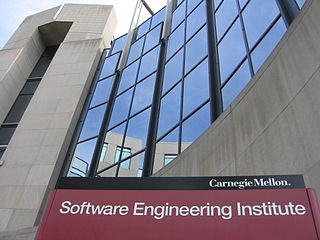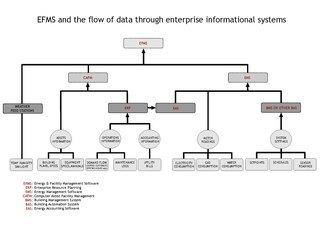The Capability Maturity Model (CMM) is a development model created in 1986 after a study of data collected from organizations that contracted with the U.S. Department of Defense, who funded the research. The term "maturity" relates to the degree of formality and optimization of processes, from ad hoc practices, to formally defined steps, to managed result metrics, to active optimization of the processes.

Software Engineering Institute (SEI) is a federally funded research and development center in Pittsburgh, Pennsylvania, United States. Founded in 1984, the institute is now sponsored by the United States Department of Defense and the Office of the Under Secretary of Defense for Research and Engineering, and administrated by Carnegie Mellon University. The activities of the institute cover cybersecurity, software assurance, software engineering and acquisition, and component capabilities critical to the United States Department of Defense.
An information system (IS) is a formal, sociotechnical, organizational system designed to collect, process, store, and distribute information. From a sociotechnical perspective, information systems comprise four components: task, people, structure, and technology. Information systems can be defined as an integration of components for collection, storage and processing of data, comprising digital products that process data to facilitate decision making and the data being used to provide information and contribute to knowledge.
The following outline is provided as an overview of and topical guide to software engineering:
Application software is any computer program that is intended for end-user use – not operating, administering or programming the computer. An application is any program that can be categorized as application software. Common types of applications include word processor, media player and accounting software.
Facility management or facilities management (FM) is a professional management discipline focused on the efficient and effective delivery of logistics and other support services related to real property and buildings. It encompasses multiple disciplines to ensure functionality, comfort, safety and efficiency of the built environment by integrating people, place, process and technology, as defined by the International Organization for Standardization (ISO). The profession is certified through Global Facility Management Association member organizations.

In industry, product lifecycle management (PLM) is the process of managing the entire lifecycle of a product from its inception through the engineering, design and manufacture, as well as the service and disposal of manufactured products. PLM integrates people, data, processes, and business systems and provides a product information backbone for companies and their extended enterprises.
ISO/IEC 15504Information technology – Process assessment, also termed Software Process Improvement and Capability dEtermination (SPICE), is a set of technical standards documents for the computer software development process and related business management functions. It is one of the joint International Organization for Standardization (ISO) and International Electrotechnical Commission (IEC) standards, which was developed by the ISO and IEC joint subcommittee, ISO/IEC JTC 1/SC 7.

Technical writing is a specialized form of communication used by many of today's industrial and scientific organizations to clearly and accurately convey complex information to a user. An organization's customers, employees, assembly workers, engineers, and scientists are some of the most common users who reference this form of content to complete a task or research a subject. Most technical writing relies on simplified grammar, supported by easy-to-understand visual communication to clearly and accurately explain complex information.
Capability Maturity Model Integration (CMMI) is a process level improvement training and appraisal program. Administered by the CMMI Institute, a subsidiary of ISACA, it was developed at Carnegie Mellon University (CMU). It is required by many U.S. Government contracts, especially in software development. CMU claims CMMI can be used to guide process improvement across a project, division, or an entire organization.

A computerized maintenance management system (CMMS) is any software package that maintains a computer database of information about an organization's maintenance operations. This information is intended to help maintenance workers do their jobs more effectively and to help management make informed decisions.
Enterprise software, also known as enterprise application software (EAS), is computer software used to satisfy the needs of an organization rather than its individual users. Enterprise software is an integral part of a computer-based information system, handling a number of business operations, for example to enhance business and management reporting tasks, or support production operations and back office functions. Enterprise systems must process information at a relatively high speed.
An integrated workplace management system (IWMS) is an ultimate software platform for organizational uses of workplace resources, including the management of real estate portfolio, infrastructure and facilities assets of a company. IWMS solutions are commonly packaged as an integrated suite or as individual modules that can be scaled over time. They are used by corporate occupiers, real estate services firms, facilities services providers, landlords and managing agents. Traditionally focused on supporting real estate and facilities professionals, IWMS solutions are becoming more employee-oriented, expanding their focus to include all building occupants and visitors.
A maturity model is a framework for measuring an organization's maturity, or that of a business function within an organization, with maturity being defined as a measurement of the ability of an organization for continuous improvement in a particular discipline. The higher the maturity, the higher will be the chances that incidents or errors will lead to improvements either in the quality or in the use of the resources of the discipline as implemented by the organization.
Drawbase Software, founded in 1986, is the developer of Drawbase, an integrated workplace management system (IWMS) and Business Infrastructure Management (BIM) solution. This product line includes several optional software applications, such as the Move Manager, Data Center Manager and the MEP Manager, which serve to enhance facility management.
In software engineering, a software development process or software development life cycle (SDLC) is a process of planning and managing software development. It typically involves dividing software development work into smaller, parallel, or sequential steps or sub-processes to improve design and/or product management. The methodology may include the pre-definition of specific deliverables and artifacts that are created and completed by a project team to develop or maintain an application.

Office space planning is the process of organizing the workplace layout, furniture and office functions to work effectively together, while using space efficiently. Floor plans should consider the workgroup function, building codes and regulations, lighting, teaming requirements, inter-communication and storage, as well as zoning for employee workstations, task space needs, support rooms and reception areas to make the best use of available space. Optimising office spaces with effective space planning can aid circulation, productivity and improve workplace wellness, as well as the health and safety of occupants.

Energy and facility management software is a term used to refer to an enterprise-wide platform for handling technical data related to buildings and stems from the merger of EMS, CAFM and EAS. As such it involves the gathering and processing or information that is required for maintaining acceptable indoor comfort level while minimizing energy use.
Bill Curtis is a software engineer best known for leading the development of the Capability Maturity Model and the People CMM in the Software Engineering Institute at Carnegie Mellon University, and for championing the spread of software process improvement and software measurement globally. In 2007 he was elected a Fellow of the Institute of Electrical and Electronics Engineers (IEEE) for his contributions to software process improvement and measurement. He was named to the 2022 class of ACM Fellows, "for contributions to software process, software measurement, and human factors in software engineering".

twiGIS is a web-based geographical information system software, developed by ARKANCE. Compatible with standard GIS and mapping technologies, like QGIS, PostGIS, AutoCAD Map 3D, What3words and ESRI, twiGIS uses a responsive user-centric web tool for publishing and managing wide range of geographic and infrastructure data as well as CAD and BIM data for utility networks and for maintenance management and facility management (CAFM) applications. You can use any type of mapping data, such as high resolution aerial images, open web maps, vector maps, CAD drawings, BIM models and databases. twiGIS supports Microsoft Edge, Google Chrome, Mozilla Firefox and Safari web browsers on desktop and mobile devices.






